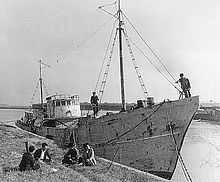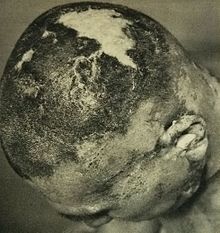Lucky Dragon V.
Happy Dragon V ( Jap. 第五福竜丸 or 第五福龍丸 , Dai-go Fukuryū-maru ) is a Japanese fishing boat , on March 1, 1954 at the area of the fallout of nuclear weapons tests Castle Bravo was contaminated. Numerous crew members died as a result.
history
The boat was built in 1947 in the Koza shipyard in Wakayama as Dai-nana Kotoshiro-maru ( 第七 事 代 丸 ) and then used as a fishing boat in Yaizu , Shizuoka .
After the contamination , the Lucky Dragon V was decommissioned and rotted away. In the 1970s, the incident came back into the public consciousness. The boat was restored in 1976 and is now on display at the Daigo Fukuryu Maru Exhibition Hall in Tokyo .
Exposure
On February 28, 1954, the US Army ignited the most powerful American thermonuclear weapon to date on Namu Island in Bikini Atoll . The ignition took place at a height of about 2 meters, so that a lot of water and earth got into the atmosphere. The explosive force was about 2.5 times as strong as calculated. The weather and wind direction changed after the explosion . The Happy Dragon V was in the ignition 140 to 160 km from Namu away, along with 400 to 800 other Japanese boats. Afterwards, contaminated tuna was found on 683 fishing boats .
A salty, sandy rain was falling on the boat. This contained radioactive fission products .
During the journey home, which lasted until March 14, all 23 crew members fell ill with severe radiation sickness . The radio operator Aikichi Kuboyama died on September 23, 1954. The other crew members initially survived, six of them later developed liver cancer .
aftermath
The tuna from the affected boats had to be destroyed, a profound interference with food logistics for Japan. The diplomatic relationship with the United States was strained during the rapprochement between the two former war opponents. The Japanese people were very outraged and condemned the nuclear weapons test, while the American people were only sporadically informed about the incident and therefore hardly noticed it.
Implementations
Lev Petrow and Arkady Strugatski published the novel "The Ashes of Bikini" in 1956 .
Shindō Kaneto shot the film Dai-go Fukuryū-maru , which premiered on February 18, 1959 , about the incident .
Herbert Eimert composed the piece "Epitaph for Aikichi Kuboyama for speakers and speech sounds" in 1960. The world premiere took place in Darmstadt on July 9, 1962.
The incident inspired the Japanese film producer Tomoyuki Tanaka to make a monster film that a. should also address the atomic bombs dropped on Hiroshima and Nagasaki . This is how the Godzilla series came about .
Web links
Individual evidence
- ^ Federal Agency for Civic Education: Sebastian Deterding: Hiroshima: A Chronicle - From the Discovery of Uranium to the End of the Cold War
- ^ Internet Movie Database
- ↑ Gernot Gricksch: Godzilla. From Japan to Hollywood: Everything about the most famous monster in film history Wilhelm Heyne Verlag GmbH & Co. KG, Munich 1998, ISBN 3-453-13836-8 .
Coordinates: 35 ° 39 ′ 3.4 " N , 139 ° 49 ′ 34.8" E



